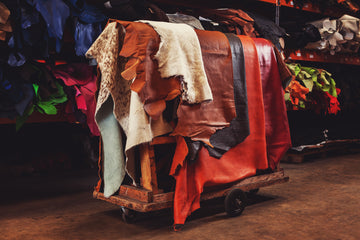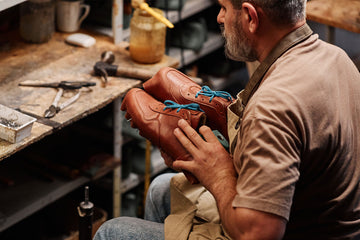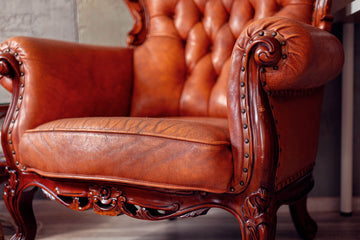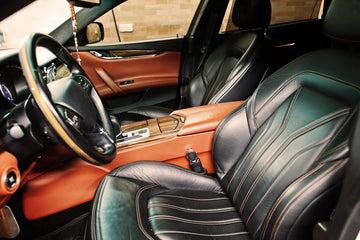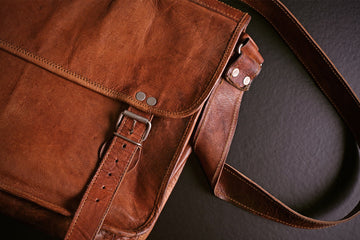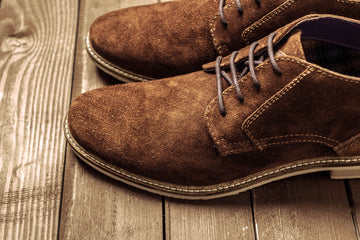Unravelling the best types of leather for shoe making involves examining a mix of texture, strength, and aesthetic qualities. Full-grain leather is the superior selection for the perfect footwear material due to its renowned durability and timeless charm.
As we delve into the variety of shoe leathers available, ranging from calfskin's delicate finesse to top grain's robust endurance, we aim to guide you towards selecting the most suitable type of leather to enhance your shoe creations.
Key Takeaways
The quality of leather, precisely Grade 1 and full-grain leather, is fundamental to footwear's durability, comfort, and aesthetic appeal.
Full-grain and top-grain leathers are prized for their resilience and aesthetic quality, with full-grain being the most durable and top-grain offering a balance between suppleness and strength.
Exotic leathers offer luxury and uniqueness, suede provides casual elegance, and the tanning process (chrome vs vegetable-tanned) affects the leather's character and environmental impact.
Evaluating Leather Quality for Footwear
In shoe manufacturing, the calibre of leather is crucial and influences aspects like durability, comfort, and aesthetic allure. Imagine a polished boot that captivates onlookers and endures over time. This level of exceptional footwear craftsmanship starts with selecting top-grade leather sourced from specific regions of the animal hide.
Enthusiasts know that Grade 1 leather stands atop in quality due to its few imperfections. It is often the leather type chosen for crafting the upper part of high-end shoes—the most visible and significant component. The posterior segment from a Grade 1 hide represents an apex standard within this industry. At the same time, other leathers are designated as corrected grain signals, which are a notch lower in prestige because they require substantial finishing to mask their flaws.
The Premier Choice: Full Grain Leather
Imagine a type of leather that effortlessly repels moisture, remains unsoiled amidst the dirt, and stands the test of time without cracking or peeling—this is the hallmark of full-grain leather. This superior material's tightly packed natural fibres grant it exceptional strength while simultaneously providing an unmatched visual charm.
Such is the reverence for this fabric that shell cordovan has become synonymous with luxury men's dress shoes. It represents a harmonious blend of elegance and durability, making it a prized choice for premium footwear.
The Natural Beauty of Full Grain
Full-grain leather matures similarly to an exquisite wine, accruing a distinguished patina as individualistic as a fingerprint, becoming more refined with each interaction and time. Vegetable-tanned full-grain aniline leather, showcasing its natural grain without any obscuring surface layers, provides a texture and appearance of genuine leather authenticity.
Longevity and Wear
Full-grain leather is the epitome of durable leather, designed to endure daily wear while preserving its strength and aesthetic appeal. As it naturally creases and wears over time, full-grain forms a unique pattern that bears witness to the wearer's individual experiences. This type of grain in the leather upholds its reputation as the most robust option and becomes a symbolic narrative of one's adventures.
Top Grain Leather: A Versatile Alternative
In the leather world, top-grain leather is celebrated for its adaptable nature and smooth surface, achieved by buffing out natural flaws. Due to its flexibility and resistance to stains, this type of leather effortlessly moulds into numerous shoe styles, ranging from sleek formal shoes to casual sandals and loafers. However, despite being a favoured choice in footwear production, it doesn't quite match the durability and breathability of full-grain leather.
Learn the essentials of shoemaking with our beginner's guide on choosing the right leather for your shoe making projects.
Balancing Aesthetics and Durability
Top-grain leather is an ideal combination—it's flexible and robust, with a pleasing appearance that doesn't sacrifice endurance. This material, known for its sleek finish, is favoured in crafting various shoe designs that suit everyday wear and sophisticated tastes.
The Tanning Process Impact
The method of tanning top-grain leather confers a unique combination of benefits, including:
- Improved resistance against stains and wear.
- Increased longevity.
- Even colour distribution.
- A texture that is both soft to the touch and smooth.
Nevertheless, it should be acknowledged that during this process, some of the inherent breathability found in natural leather may be forfeited to achieve these enhancements.
The Allure of Calf Leather
The exquisite texture of calf leather, with its fine grain, is a testament to its premium origin. Young calves are usually no more than a year old. This leather combines an effortlessly sleek appearance with resilience and strength, making it an ideal choice for creating top-tier dress shoes and boots. Renowned for both its durability and velvety smoothness, calf leather has the remarkable ability to age well.
Softness and Strength Combined
The appeal of calfskin leather lies in its unique combination—it is both supple and durable, ensuring longevity. This desirable quality makes it highly sought after for its gentle feel and resistance to wear and tear. Only the finest sections of the calf hide are selected, guaranteeing resilience and a consistent texture throughout.
Calf Leather Aging Gracefully
Calf leather boasts a patina that bears witness to its high quality, gracefully transitioning from a pale beige hue to deep chocolate tones—a sumptuous and sought-after change. This maturation, shaped by various environmental elements, can span anywhere between half a year to multiple years, cultivating an unparalleled individuality in the character of the leather.
Genuine leather—especially top-grain calf with an embossed texture—ages with elegance, skilfully masking folds while preserving its aesthetic longevity. On the other hand, split leather might lack these superior ageing characteristics.
Suede Leather: Casual Elegance
Crafted from the underside of animal hide, suede leather is respected for its softness and durability. Its matte finish and availability in various vibrant hues have rendered it a fashionable option for footwear. Suede's luxurious texture provides casual elegance and makes it a preferred material for upscale accessories.
Maintenance of Suede
While the beauty of suede shoes is undeniable, they demand a particular level of care to prevent staining and water damage. Here are some tips to keep your suede shoes looking pristine.
- Regularly brush your suede shoes with a suede brush to maintain the nap.
- Use a specialised specialised cleaner for deeper stains.
- Avoid wearing suede shoes in wet conditions to prevent water damage.
By following these tips, you can ensure that your suede shoes stay in excellent condition for a long time. Waterproofing sprays and maintenance kits designed for suede and nubuck leather can protect these delicate materials.
When to Choose Suede
Suede, a material revered for its distinctive texture and casual sophistication, serves as the pinnacle of relaxed elegance in shoes. Although it's favoured for making elegant dress shoes, suede is not advisable for outdoor or heavy-duty shoes or boots because of its fragile constitution and propensity to soak up water.
Exploring Exotic Leathers
Exotic leathers offer unparalleled luxury and exclusivity not found in ordinary leathers. The remarkable patterns of alligator skin or the singular textures presented by ostrich leather impart a rare quality, transforming footwear into an opulent fashion statement.
Despite commanding a higher upfront price, these leathers also provide enhanced durability and functionality. This justifies their esteemed status within the realm of upscale footwear, making sneakers a practical investment for those seeking both style and substance.
Exotic Leather Care
Preserving exotic leather footwear's distinctive shape and look involves more than just sporadic cleaning. It demands a consistent level of care. Boot trees, frequent gentle dusting, and careful conditioning can keep them free from cracks and in prime condition.
It is advisable to apply a neutral paste or wax polish to polished shoes to boost their lustre while safeguarding specific areas such as skin, such as the toes and heels.
Chrome Tanned vs. Vegetable Tanned Leather
The tanning method fundamentally shapes both the distinctive qualities of leather and its ecological impact. Leather products predominantly consist of chrome-tanned leather, which is favoured for its rapid manufacturing timeline and an extensive assortment of colours and various materials.
Alternatively, vegetable—tanned leather—often referred to as vegetable—tanned leather—is celebrated for being an environmentally conscious option. This type of sheep leather matures gradually but yields a robust material ideal for crafting premium-quality footwear.
Chrome Tanned Leather: Colourful and Soft
Leather that has undergone chrome tanning offers many colours, surpassing the conventional shades in other leather types treated with vegetable tannins. It is the most popular leather for its ability to maintain consistent colour and inherent softness, and it is highly sought after by those seeking comfort and a plush feel in their footwear.
Vegetable Tanned Leather: Eco-Friendly and Sturdy
Vegetable-tanned leather is an environmentally friendly option because it uses natural plant substances for tanning. This durable material gains a distinctive patina over time and is highly prized in custom shoemaking due to its quality and character.
Patent Leather: The High Shine Option
Regarding events requiring meticulous attention to every element, leather shoes with a full patent leather top finish stand out as the ultimate selection. Their lustrous appearance exudes elegance, and their ability to repel water and dirt simplifies upkeep.
The distinctive reflective quality of patent leather owes its brilliance to a coating made from polyurethane and acrylic solution, which gives the upper leather of these shoes their notable high shine.
Nubuck Leather: Tough Yet Elegant
Nubuck leather epitomises sophistication with its soft texture reminiscent of suede, yet it boasts a surprising durability that makes it an esteemed choice for crafting men's footwear. This material features a coarse-grain and fine-grain side, seamlessly adding to elegant and relaxed styles. Its strong resistance to wear stands as a testament to the enduring quality of nubuck shoes.
Corrected Grain Leather: Polished and Practical
Bookbinder leather, corrected grain leather, is respected for its glossy finish and functional qualities. The features of this type of leather are:
A Shinier and Thicker Coating
Achieved through sanding and buffing to produce an even surface
Begins rather stiff but can become more flexible over time
It tends toward cracking and pronounced creasing owing to its rugged exterior
As leather is a material that proves challenging to repair once it sustains damage, the durability of corrected grain leather should be carefully weighed when selecting it for use in footwear.
Selecting Leather for Specific Shoe Parts
Crafting footwear is a meticulous process in which the function of every segment dictates the choice of the best leather qualities, from demanding flexion resistance in outsoles to seeking just the right heel stiffness. Thus, This crucial leather selection shapes performance and defines the shoes' calibre.
Different leather mores are employed for parts like soles, insoles, linings, and uppers. Each contributes uniquely to both practicality and style. They impact all aspects, from maintaining structural integrity to ensuring user comfort within each shoe's design.
Sole Selection: Durable Leather for Longevity
Shoe soles are often overlooked workhorses, perpetually engaging with the terrain and absorbing constant abrasion. It is imperative to choose robust and durable leather for shoes, especially footwear leather that can withstand significant stress, such as stiff, vegetable-tanned cowhide known for its resilience. In this context, shoe leather becomes an essential element in maintaining the long-term durability of footwear.
Particularly when it comes to men's shoes, there is a need for thick and resilient outsole leather capable of handling regular use. With varying sole thickness options ranging from 4.5mm to 7.0mm available on the market today, one has the flexibility to have different thicknesses and customise the sole durability according to how much abuse they expect their shoe to encounter.
Lining Leather: Comfort Inside Out
The inner sanctum of a shoe, crucial for maintaining comfort and dryness, relies on the breathability of its lining. This key feature assists in averting moisture accumulation and is essential in comforting the foot. Soft leather linings enhance airflow within the shoe, which helps to keep feet dry and lessens foot odour.
Popular leathers such as calfskin and sheepskin are preferred for their inherent flexibility and tendency to adapt perfectly to the contours of one's foot. These leathers offer an agreeable fit that is both cosy and form-fitting.
Upper Considerations: Style Meets Substance
Choosing the appropriate shoe upper and leather is pivotal in shoe design, as it forms the intersection of fashion and durability. Opting for grain leather for the shoe's upper shoe enhances its visual appeal and ensures superior ageing properties. Grain leathers like pull-ups are especially prized due to their remarkable ability to alter hue when bending or tension, bringing an engaging changeability to footwear uppers.
Despite its finer texture and rarity in everyday use, deerskin offers a specialised option for crafting uppers requiring a softer touch and minimal structure. It excels particularly in more casual types of shoes, such as loafers and slippers, where flexibility takes precedence over rigidity.
Summary
In the journey through the world of leather, we've encountered the durable and the delicate, the polished and the practical. Each type brings unique qualities from the peerless full-grain leather, ideal for the discerning wearer, to the casual elegance of suede.
Calf leather ages with grace, while exotic leathers add a touch of the extraordinary to your footwear collection. Whether navigating the tanning processes or selecting the perfect leather for each shoe part, this guide is your compass to make informed choices that blend style, comfort, and durability. Let the knowledge imparted here inspire you to step forward in shoes made not just of the best leather around but of wisdom and insight.
🔗 Explore the finest leather for footwear
If you need more information about the various types and grades of leather suitable for shoe making, please feel free to contact us. We're here to help you choose the perfect leather that not only enhances the aesthetic of your footwear but also ensures its durability and longevity.
